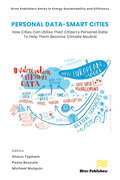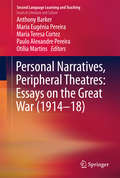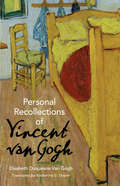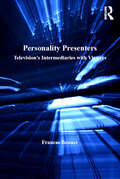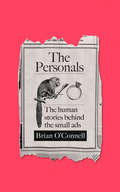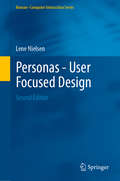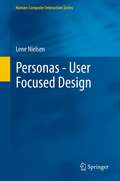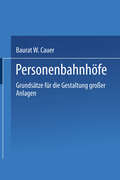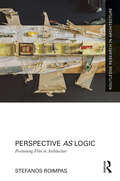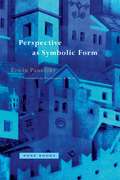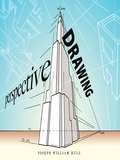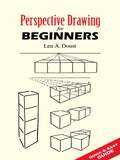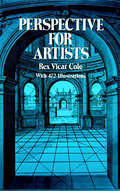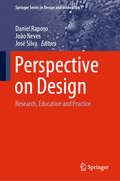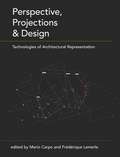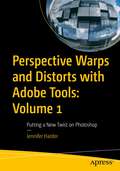- Table View
- List View
Personal Data-Smart Cities: How cities can Utilise their Citizen’s Personal Data to Help them Become Climate Neutral
by Shaun Topham Paolo Boscolo Michael MulquinThis book sets out to address some of the issues that a smart city needs to overcome to make use of both the data currently available to them and how this can be enhanced by using emerging technology enabling a citizen to share their personal data, adding value. It provides answers for those within a smart city, advising their mayors or leaders on introducing new technology. We will cover the topic so as to enable many different public officials to be able to understand the situation from their own perspective, be they lawyers, financial people, service providers, those looking at governance structures, policy makers, etc. We are contributing to the new model for the European Data Economy. Case studies of existing best practice in the use of data are augmented with examples of embracing a citizen’s personal data in the mix, to enable better services to develop and potential new revenue streams to occur. This will enable new business models and investment opportunities to emerge. We will address the topic of how to put a value on data and will conclude by looking at what new technologies will be emerging in the coming years, to help cities with carbon-neutral targets to have more chance of succeeding.
Personal Data-Smart Cities: How cities can Utilise their Citizen’s Personal Data to Help them Become Climate Neutral
This book sets out to address some of the issues that a smart city needs to overcome to make use of both the data currently available to them and how this can be enhanced by using emerging technology enabling a citizen to share their personal data, adding value. It provides answers for those within a smart city, advising their mayors or leaders on introducing new technology. We will cover the topic so as to enable many different public officials to be able to understand the situation from their own perspective, be they lawyers, financial people, service providers, those looking at governance structures, policy makers, etc. We are contributing to the new model for the European Data Economy. Case studies of existing best practice in the use of data are augmented with examples of embracing a citizen’s personal data in the mix, to enable better services to develop and potential new revenue streams to occur. This will enable new business models and investment opportunities to emerge. We will address the topic of how to put a value on data and will conclude by looking at what new technologies will be emerging in the coming years, to help cities with carbon-neutral targets to have more chance of succeeding.
Personal Narratives, Peripheral Theatres: Essays on the Great War (Second Language Learning and Teaching)
by Anthony Barker Maria Eugénia Pereira Maria Teresa Cortez Paulo Alexandre Pereira Otília MartinsThis book is a collection of essays on neglected aspects of the Great War. It begins by asking what exactly was so "Great" about it, before turning to individual studies of various aspects of the war. These fall broadly into two categories. Firstly personal, micro-narratives that deal directly with the experience of war, often derived from contemporary interest in diaries and oral histories. Presenting both a close-up view of the viscerality, and the tedium and powerlessness of personal situations, these same narratives also address the effects of the war on hitherto under-regarded groups such as children and animals. Secondly, the authors look at the impact of the course of the war on theatres, often left out in reflections on the main European combatants and therefore not part of the regular iconography of the trenches in places such as Denmark, Canada, India, the Levant, Greece and East Africa.
Personal Recollections of Vincent Van Gogh
by Elisabeth Duqesne Van Gogh Katherine S. DreierRejected in their day by painters, critics, and collectors, the visions of Vincent Van Gogh now rank among the most beloved and influential works in the history of Western art. The artist sold only a single painting in his lifetime, despite an abundant oeuvre of more than 2,000 artworks. Today his paintings fetch tens of millions at auction, and visitors from around the world flock to Amsterdam's Van Gogh Museum. The artist's life of grinding poverty, his severe mental illness, and the derision of his contemporaries combined to form a romantic ideal of the tortured artist. Twenty-three years after Van Gogh's suicide, in the wake of his slowly growing fame, the painter's sister published this memoir. An intimate view of the artist's life, art, and philosophy, the book is illustrated with reproductions of several of Van Gogh's most characteristic works, including portraits and landscapes.
Personality Presenters: Television's Intermediaries with Viewers
by Frances BonnerTelevision presenters are key to the sociability of the medium, speaking directly to viewers as intermediaries between audiences and those who are interviewed, perform or compete on screen. As targets of both great affection and derision from viewers and the subjects of radio, internet, magazine and newspaper coverage, many have careers that have lasted almost as long as post-war television itself. Nevertheless, as a profession, television presenting has received little scholarly attention. Personality Presenters explores the role of the television presenter, analysing the distinct skills possessed by different categories of host and the expectations and difficulties that exist with regard to the promotion of the various films, books, consumer and cultural products with which they are associated. The close involvement of presenters with the content that they present is examined, while the impact of the presenters' own celebrity on the tasks that they perform is scrutinised. With a focus on non-fiction entertainment shows such as game shows, lifestyle and reality shows, chat, daytime and talk shows, this book explores issues of consumer culture, advertising and celebrity, as well as the connection of presenters with ethical issues. Offering detailed case studies of internationally recognised presenters, as well comparisons between national presenters from the UK and Australia, Personality Presenters provides a rich discussion of television presenters as significant conduits in the movement of ideas. As such, it will appeal to sociologists as well as those working in the fields of popular culture, cultural and media studies and cultural theory.
Personality Presenters: Television's Intermediaries with Viewers
by Frances BonnerTelevision presenters are key to the sociability of the medium, speaking directly to viewers as intermediaries between audiences and those who are interviewed, perform or compete on screen. As targets of both great affection and derision from viewers and the subjects of radio, internet, magazine and newspaper coverage, many have careers that have lasted almost as long as post-war television itself. Nevertheless, as a profession, television presenting has received little scholarly attention. Personality Presenters explores the role of the television presenter, analysing the distinct skills possessed by different categories of host and the expectations and difficulties that exist with regard to the promotion of the various films, books, consumer and cultural products with which they are associated. The close involvement of presenters with the content that they present is examined, while the impact of the presenters' own celebrity on the tasks that they perform is scrutinised. With a focus on non-fiction entertainment shows such as game shows, lifestyle and reality shows, chat, daytime and talk shows, this book explores issues of consumer culture, advertising and celebrity, as well as the connection of presenters with ethical issues. Offering detailed case studies of internationally recognised presenters, as well comparisons between national presenters from the UK and Australia, Personality Presenters provides a rich discussion of television presenters as significant conduits in the movement of ideas. As such, it will appeal to sociologists as well as those working in the fields of popular culture, cultural and media studies and cultural theory.
Personalmanagement in Zeiten des Fachkräftemangels: Schnelleinstieg für Architekten und Bauingenieure (essentials)
by Dietmar GoldammerAufgrund des Wandels in unserer Gesellschaft wird es Veränderungen in den Unternehmen geben, die auch vor den Planungsbüros nicht haltmachen. Dieser Wandel betrifft auch das Personalmanagement. Der Autor gibt Tipps, wie man sich dabei in Zukunft aufstellen könnte.Der Autor:Dr. Dietmar Goldammer ist Diplom-Kaufmann und Unternehmensberater für Architekten und Ingenieure. Er gibt als Dozent Seminare zur Betriebswirtschaft für Planer und ist Fachbuchautor zahlreicher Publikationen zum Thema Betriebswirtschaft. Er ist Vorstandsmitglied der Praxisinitiative erfolgreiches Planungsbüro (PeP) in Berlin.
The Personals
by Brian O’ConnellThe Personals reveals how classified ads are not just a few commercial lines of text in print or online – they can be a treasure trove of fascinating human stories; stories of love, loss, loneliness, redemption and hope.
Personas - User Focused Design: User Focused Design (Human–Computer Interaction Series #15)
by Lene NielsenPeople relate to other people, not to simplified types or segments. This is the concept that underpins this book. Personas, a user centered design methodology, covers topics from interaction design within IT, through to issues surrounding product design, communication, and marketing. Project developers need to understand how users approach their products from the product’s infancy, and regardless of what the product might be. Developers should be able to describe the user of the product via vivid depictions, as if they – with their different attitudes, desires and habits – were already using the product. In doing so they can more clearly formulate how to turn the product's potential into reality. Based on 20 years’ experience in solving problems for businesses and 15 years of research, currently at the IT University of Copenhagen, Lene Nielsen is Denmark’s leading expert in the persona method. She has a PhD in personas and scenarios, and through her research and practical experiences has developed her own approach to the method – 10 Steps to Personas. This second edition of Personas – User Focused Design presents a step-by-step methodology of personas which will be of interest to developers of IT, communications solutions and innovative products. This book also includes three new chapters and considerable expansion on the material in the first edition.
Personas - User Focused Design (Human–Computer Interaction Series #15)
by Lene NielsenPeople relate to other people, not to simplified types or segments. This is the concept that underpins this book. Personas, a user centered design methodology covers topics from interaction design within IT, through to issues surrounding product design, communication, and marketing.Project developers need to understand how users approach their products from the product’s infancy, and regardless of what the product might be. Developers should be able to describe the user of the product via vivid depictions, as if they – with their different attitudes, desires and habits – were already using the product. In doing so they can more clearly formulate how to turn the product's potential into reality.With contributions from professionals from Australia, Brazil, Finland, Japan, Russia, and the UK presenting real-world examples of persona method, this book will provide readers with valuable insights into this exciting research area. The inspiration to create user descriptions includes character-driven narratives, and the film Thelma & Louise is analyzed in order to understand how the development process can also be an engaging story in various professional contexts.With a solid foundation in her own research at the IT University of Copenhagen and more than five years of experience in solving problems for businesses, Lene Nielsen is Denmark’s leading expert in the persona method. She has a PhD in personas and scenarios, and through her research and practical experiences she has developed her own approach to the method – 10 Steps to Personas. Personas – User Focused Design presents a step-by-step methodology of personas which will be of interest to developers of IT, communications solutions and innovative products.
Personen beschreiben, Leben erzählen: Die Fernsehporträts von Georg Stefan Troller und Hans-Dieter Grabe
by Christian HißnauerDas jeweils einzigartige Œuvre von Georg Stefan Troller und Hans-Dieter Grabe wird hier erstmals werk- und fernsehhistorisch umfassend analysiert. Ausführlich werden die dokumentarischen Methoden dieser wichtigen Wegbereiter des deutschen Fernsehdokumentarismus erläutert und ihre dramaturgischen und ästhetischen Konzepte beschrieben.
Personenbahnhöfe: Grundsätze für die Gestaltung großer Anlagen
by Wilhelm Adolf CauerDieser Buchtitel ist Teil des Digitalisierungsprojekts Springer Book Archives mit Publikationen, die seit den Anfängen des Verlags von 1842 erschienen sind. Der Verlag stellt mit diesem Archiv Quellen für die historische wie auch die disziplingeschichtliche Forschung zur Verfügung, die jeweils im historischen Kontext betrachtet werden müssen. Dieser Titel erschien in der Zeit vor 1945 und wird daher in seiner zeittypischen politisch-ideologischen Ausrichtung vom Verlag nicht beworben.
Perspective as Logic: Positioning Film in Architecture (Routledge Research in Architecture)
by Stefanos RoimpasPerspective as Logic offers an architectural examination of the filmic screen as an ontologically unique element in the discipline’s repertoire. The book determines the screen’s conditions of possibility by critically asking not what a screen means, but how it can mean anything of architectural significance. Based on this shift of enquiry towards the question of meaning, it introduces Jacques Lacan and Alain Badiou in an unprecedented way to architecture—since they exemplify an analogous shift of perspective towards the question of the subject and the question of being accordingly. The book begins by positing perspective projection as being a logical mapping of space instead of a matter of sight (Alberti & Lacan). Secondly, it discusses the very nature of architecture’s view and relation to the topological notion of outside between immediacy and mediation (Diller and Scofidio, The Slow House). It examines the limitation of pictorial illusion and the productive negativity in the suspension of architecture’s signified equivalent to language’s production of undecidable propositions (Eisenman & Badiou). In addition, the book outlines the difference between the point of view and the vanishing point by introducing two different conceptions of infinity (Michael Webb, Temple Island). Finally, a series of design experiments playfully shows how the screen exemplifies architecture’s self-reflexive capacity where material and immaterial components are part of the spatial conception to which they refer and produce. This book will be particularly appealing to scholars of architectural theory, especially those interested in the domains of philosophy, psychoanalysis and the linguistic turn of architecture.
Perspective as Logic: Positioning Film in Architecture (Routledge Research in Architecture)
by Stefanos RoimpasPerspective as Logic offers an architectural examination of the filmic screen as an ontologically unique element in the discipline’s repertoire. The book determines the screen’s conditions of possibility by critically asking not what a screen means, but how it can mean anything of architectural significance. Based on this shift of enquiry towards the question of meaning, it introduces Jacques Lacan and Alain Badiou in an unprecedented way to architecture—since they exemplify an analogous shift of perspective towards the question of the subject and the question of being accordingly. The book begins by positing perspective projection as being a logical mapping of space instead of a matter of sight (Alberti & Lacan). Secondly, it discusses the very nature of architecture’s view and relation to the topological notion of outside between immediacy and mediation (Diller and Scofidio, The Slow House). It examines the limitation of pictorial illusion and the productive negativity in the suspension of architecture’s signified equivalent to language’s production of undecidable propositions (Eisenman & Badiou). In addition, the book outlines the difference between the point of view and the vanishing point by introducing two different conceptions of infinity (Michael Webb, Temple Island). Finally, a series of design experiments playfully shows how the screen exemplifies architecture’s self-reflexive capacity where material and immaterial components are part of the spatial conception to which they refer and produce. This book will be particularly appealing to scholars of architectural theory, especially those interested in the domains of philosophy, psychoanalysis and the linguistic turn of architecture.
Perspective as Symbolic Form: An Essay On Infinite Naming
by Erwin PanofskyErwin Panofsky’s Perspective as Symbolic Form is one of the great works of modern intellectual history, the legendary text that has dominated all art-historical and philosophical discussions on the topic of perspective in this century. Finally available in English, this unrivaled example of Panofsky’s early method places him within broader developments in theories of knowledge and cultural change.Here, drawing on a massive body of learning that ranges over ancient philosophy, theology, science, and optics as well as the history of art, Panofsky produces a type of “archaeology” of Western representation that far surpasses the usual scope of art historical studies.Perspective in Panofsky’s hands becomes a central component of a Western “will to form,” the expression of a schema linking the social, cognitive, psychological, and especially technical practices of a given culture into harmonious and integrated wholes. He demonstrates how the perceptual schema of each historical culture or epoch is unique and how each gives rise to a different but equally full vision of the world.Panofsky articulates these distinct spatial systems, explicating their particular coherence and compatibility with the modes of knowledge, belief, and exchange that characterized the cultures in which they arose. Our own modernity, Panofsky shows, is inseparable from its peculiarly mathematical expression of the concept of the infinite, within a space that is both continuous and homogenous.
Perspective as Symbolic Form
by Erwin PanofskyErwin Panofsky’s Perspective as Symbolic Form is one of the great works of modern intellectual history, the legendary text that has dominated all art-historical and philosophical discussions on the topic of perspective in this century. Finally available in English, this unrivaled example of Panofsky’s early method places him within broader developments in theories of knowledge and cultural change.Here, drawing on a massive body of learning that ranges over ancient philosophy, theology, science, and optics as well as the history of art, Panofsky produces a type of “archaeology” of Western representation that far surpasses the usual scope of art historical studies.Perspective in Panofsky’s hands becomes a central component of a Western “will to form,” the expression of a schema linking the social, cognitive, psychological, and especially technical practices of a given culture into harmonious and integrated wholes. He demonstrates how the perceptual schema of each historical culture or epoch is unique and how each gives rise to a different but equally full vision of the world.Panofsky articulates these distinct spatial systems, explicating their particular coherence and compatibility with the modes of knowledge, belief, and exchange that characterized the cultures in which they arose. Our own modernity, Panofsky shows, is inseparable from its peculiarly mathematical expression of the concept of the infinite, within a space that is both continuous and homogenous.
Perspective Drawing
by Joseph William HullThis richly illustrated guide to perspective drawing features 17 reproductions of ancient and modern art, plus more than 200 instructive figures. The first half encourages freehand drawing, cultivating practical exposure to the principles of perspective. The second part addresses the laws and theories that constitute the science of perspective.Encouraging students to begin immediately with pencil drawings, the first part examines the application of perspective to depicting light and shade, textured objects, and imaginary as well as existing forms. The second part deals exclusively with rules of perspective, covering a wide scope and explaining the mechanics of perspective thoroughly and yet simply. Intended as an auxiliary to the first half's drawing instructions, part two is organized for ready reference as students progress through part one.
Perspective Drawing for Beginners
by Len A. DoustThe amateur artist faces many challenges. To Len A. Doust, perspective is by far the most problematic. With his trademark humor, the author/artist turns his expert eye toward that "dreaded, horrid word." In a clearly written how-to guide on mastering the art of perspective, he carefully:* describes the roles of lines, boxes, and circles* provides shortcuts for visualizing shapes and forms* incorporates thirty-three plates of helpful illustrationsOne of the most concise introductions available for beginners, this practical volume will be an important addition to any artist's resource library.
Perspective Drawing for Interior Space
by Christopher NataleUsing step-by-step instructions together with line-colored drawings, Perspective Drawing for Interior Space offers procedural instruction that covers freehand and technical one-, two-, and three-point perspectives. This text begins with the basic fundamentals of perspective by utilizing geometric shapes (cubes, cones, pyramids) and then advances beyond the core skills, to creating furniture, and finally, complete interior spaces. Students will learn to use grids to help them draw scale and proportion in perspective. The text also teaches students to use floor plans and elevations to create these drawings.
Perspective for Artists (Dover Art Instruction Ser.)
by Rex Vicat ColeRex Vicat Cole makes learning about perspective an enjoyable and fascinating pursuit in this clearly written and profusely illustrated book. Over 390 diagrams illustrate every aspect of the text, and more than 80 illustrations reproduce drawings and paintings — by old masters and by the author — that indicate how perspective is utilized in practice. The book is so well illustrated that many perspective problems can be answered without reference to the text at all. The text itself clarifies the theory of perspective and offers numerous practice exercises. Among the topics covered are the principle of perspective in theory, the rules of perspective and their application, depths, the use of plans in sketching foreshortened surfaces, inclined planes, the circle, arches, how to draw curves by straight lines, perspective of the sky and sea, perspective of shadows, and more. Two additional sections cover perspective in the history of art and mechanical perspective.A noted landscape painter and art instructor, Mr. Cole combines common sense with an understanding of Nature's laws to make perspective a subject that every artist can approach with confidence. Art students will also find this book extremely valuable.
Perspective on Design: Research, Education and Practice (Springer Series in Design and Innovation #1)
by Daniel Raposo João Neves José SilvaThis book presents the outcomes of recent endeavors that are expected to foster significant advances in the areas of communication design, fashion design, interior design, and product design, as well as overlapping areas. The fourteen chapters highlight carefully selected contributions presented during the 6th EIMAD conference, held on February 22–23, 2018 at the School of Applied Arts, Campus da Talagueira, in Castelo Branco, Portugal. They report on outstanding advances that offer new theoretical perspectives and practical research directions in design, and which are aimed at fostering communication in a global, digital world, while also addressing key individual and societal needs.
Perspective, Projections and Design: Technologies of Architectural Representation
by Mario Carpo Édérique LemerleThe essays selected for this book, presented in chronological order, discuss various aspects of image-making technologies, geometrical knowledge and tools for architectural design, focusing in particular on two historical periods marked by comparable patterns of technological and cultural change. The first is the Renaissance; characterized by the rediscovery of linear perspectives and the simultaneous rise of new formats for architectural drawing and design on paper; the second, the contemporary rise of digital technologies and the simultaneous rise of virtual reality and computer-based design and manufacturing. Many of the contributing authors explore the parallel between the invention of the perspectival paradigm in early-modern Europe and the recent development of digitized virtual reality. This issue in turn bears on the specific purposes of architectural design, where various representational tools and devices are used to visualize bi-dimensional aspects of objects that must be measured and eventually built in three-dimensional space.
Perspective, Projections and Design: Technologies of Architectural Representation
by Mario Carpo Frédérique LemerleThe essays selected for this book, presented in chronological order, discuss various aspects of image-making technologies, geometrical knowledge and tools for architectural design, focusing in particular on two historical periods marked by comparable patterns of technological and cultural change. The first is the Renaissance; characterized by the rediscovery of linear perspectives and the simultaneous rise of new formats for architectural drawing and design on paper; the second, the contemporary rise of digital technologies and the simultaneous rise of virtual reality and computer-based design and manufacturing. Many of the contributing authors explore the parallel between the invention of the perspectival paradigm in early-modern Europe and the recent development of digitized virtual reality. This issue in turn bears on the specific purposes of architectural design, where various representational tools and devices are used to visualize bi-dimensional aspects of objects that must be measured and eventually built in three-dimensional space.
Perspective Warps and Distorts with Adobe Tools: Putting a New Twist on Photoshop
by Jennifer HarderGain skills in image and logo manipulation that will enhance your designs and make them more appealing--either in your portfolio or for your client’s next graphic project.As Adobe's Photoshop and Illustrator have evolved, new and unique features have been added to these programs that offer different options for warping and distorting graphics and shapes. For the beginner and intermediate student or graphic artist, choosing or knowing which distort or warp tool to use among so many available can become overwhelming and confusing.This book primarily focuses on teaching how to work with various warping tools and filters in Photoshop, though you will also be using graphics acquired from Adobe Illustrator. Knowing how to work between these two applications is a crucial part of understanding how to successfully manipulate your designs. In Photoshop, you'll see how to alter both raster images and vector graphics, and learn how to do this with layers in various non-destructive ways. Some of the filters mentioned in this book will be familiar to you, as you may have used them frequently. However, others are well hidden, are new, or perhaps you have never considered that you could use that tool, dialog box, or filter to warp or distort. What You Will LearnBecome proficient in using the warping and distorting tools and filters in Photoshop, as well as how to correct basic distortions in photos and add perspectiveGrasp transferring illustrations from Illustrator for use in PhotoshopDiscover how to warp and distort typeGenerate unique patternsWork with Smart Object Layers and Smart FiltersWork in combination with older tools and newer, enhanced ones Who This Book Is ForBeginner- and Intermediate-level readers interested in pursuing careers as graphic artists, photographers, or video artists/animators.
Perspective Warps and Distorts with Adobe Tools: Putting a New Twist on Illustrator
by Jennifer HarderGain skills in illustration and logo manipulation that will enhance your designs and make them more appealing--either in your portfolio or for your client’s next graphic project.As Adobe's Photoshop and Illustrator have evolved, new and unique features have been added to these programs that offer different options for warping and distorting graphics and shapes. For the beginner and intermediate student or graphic artist, choosing or knowing which distort or warp tool to use among so many available can become overwhelming and confusing.This book primarily focuses on teaching how to work with various warping tools and effect filters in Illustrator, though you will also be using or comparing graphics from Adobe Photoshop. Knowing how to work between these two applications is a crucial part of understanding how to successfully manipulate your designs. In Illustrator, you'll see how to alter vector graphics, and learn how to do this with your Layers panel in various non-destructive ways. Some of the tools mentioned in this book will be familiar to you, as you may have used them frequently. However, others are well hidden, are new, or perhaps you have never considered that you could use that tool, dialog box, or filter effect to warp or distort. What You Will LearnBecome proficient in using the warping and distorting tools and effects in IllustratorDiscover how to add perspective to your design or make them look three dimensional Work with the Appearance panel, Graphic Styles, and SymbolsCombine older tools and newer, enhanced onesWho This Book Is ForBeginner- and Intermediate-level readers interested in pursuing careers as graphic artists, photographers, or video artists/animators.
